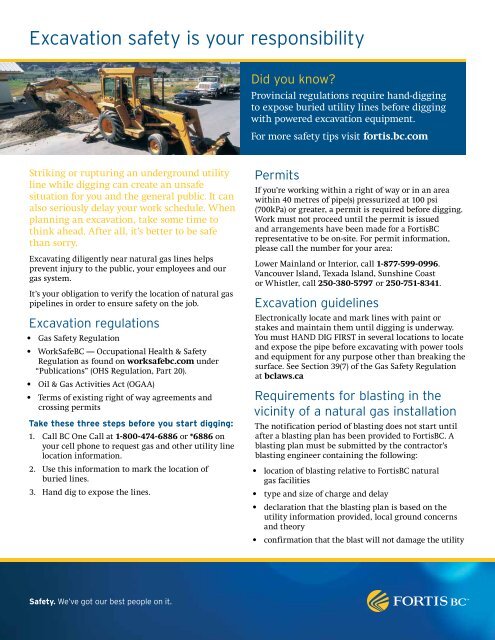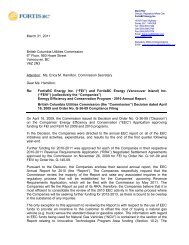Excavation safety is your responsibility - FortisBC
Excavation safety is your responsibility - FortisBC
Excavation safety is your responsibility - FortisBC
Create successful ePaper yourself
Turn your PDF publications into a flip-book with our unique Google optimized e-Paper software.
<strong>Excavation</strong> <strong>safety</strong> <strong>is</strong> <strong>your</strong> <strong>responsibility</strong><br />
Striking or rupturing an underground utility<br />
line while digging can create an unsafe<br />
situation for you and the general public. It can<br />
also seriously delay <strong>your</strong> work schedule. When<br />
planning an excavation, take some time to<br />
think ahead. After all, it’s better to be safe<br />
than sorry.<br />
Excavating diligently near natural gas lines helps<br />
prevent injury to the public, <strong>your</strong> employees and our<br />
gas system.<br />
It’s <strong>your</strong> obligation to verify the location of natural gas<br />
pipelines in order to ensure <strong>safety</strong> on the job.<br />
<strong>Excavation</strong> regulations<br />
• Gas Safety Regulation<br />
• WorkSafeBC — Occupational Health & Safety<br />
Regulation as found on worksafebc.com under<br />
“Publications” (OHS Regulation, Part 20).<br />
• Oil & Gas Activities Act (OGAA)<br />
• Terms of ex<strong>is</strong>ting right of way agreements and<br />
crossing permits<br />
Take these three steps before you start digging:<br />
1. Call BC One Call at 1-800-474-6886 or *6886 on<br />
<strong>your</strong> cell phone to request gas and other utility line<br />
location information.<br />
2. Use th<strong>is</strong> information to mark the location of<br />
buried lines.<br />
3. Hand dig to expose the lines.<br />
Safety. We’ve got our best people on it.<br />
Did you know?<br />
Provincial regulations require hand-digging<br />
to expose buried utility lines before digging<br />
with powered excavation equipment.<br />
For more <strong>safety</strong> tips v<strong>is</strong>it fort<strong>is</strong>.bc.com<br />
Permits<br />
If you’re working within a right of way or in an area<br />
within 40 metres of pipe(s) pressurized at 100 psi<br />
(700kPa) or greater, a permit <strong>is</strong> required before digging.<br />
Work must not proceed until the permit <strong>is</strong> <strong>is</strong>sued<br />
and arrangements have been made for a Fort<strong>is</strong>BC<br />
representative to be on-site. For permit information,<br />
please call the number for <strong>your</strong> area:<br />
Lower Mainland or Interior, call 1-877-599-0996.<br />
Vancouver Island, Texada Island, Sunshine Coast<br />
or Wh<strong>is</strong>tler, call 250-380-5797 or 250-751-8341.<br />
<strong>Excavation</strong> guidelines<br />
Electronically locate and mark lines with paint or<br />
stakes and maintain them until digging <strong>is</strong> underway.<br />
You must HAND DIG FIRST in several locations to locate<br />
and expose the pipe before excavating with power tools<br />
and equipment for any purpose other than breaking the<br />
surface. See Section 39(7) of the Gas Safety Regulation<br />
at bclaws.ca<br />
Requirements for blasting in the<br />
vicinity of a natural gas installation<br />
The notification period of blasting does not start until<br />
after a blasting plan has been provided to Fort<strong>is</strong>BC. A<br />
blasting plan must be submitted by the contractor’s<br />
blasting engineer containing the following:<br />
• location of blasting relative to Fort<strong>is</strong>BC natural<br />
gas facilities<br />
• type and size of charge and delay<br />
• declaration that the blasting plan <strong>is</strong> based on the<br />
utility information provided, local ground concerns<br />
and theory<br />
• confirmation that the blast will not damage the utility
Safe digging practices<br />
1. “Hand dig” to locate and expose all buried facilities<br />
before using powered excavation equipment as per<br />
provincial regulations.<br />
2. Powered equipment must not be used within one<br />
metre of the gas line when locating and exposing.<br />
3. Wherever possible, powered excavation equipment<br />
should be operated to dig parallel to the direction of<br />
the gas line.<br />
4. If it <strong>is</strong> not practical to hand dig, hydrovacing may be<br />
considered. Check with Fort<strong>is</strong>BC before hydrovacing<br />
to avoid damaging pipe coating or wrapping.<br />
5. You must obtain additional location information and<br />
approvals if you w<strong>is</strong>h to excavate outside the area for<br />
which gas line location records have been provided.<br />
6. You are not authorized to cut or remove inactive<br />
natural gas lines.<br />
7. Notify Fort<strong>is</strong>BC when a pipe or the coating <strong>is</strong><br />
damaged, so an inspection and repair can be done.<br />
8. If <strong>your</strong> project <strong>is</strong> delayed and excavation work has<br />
not started within 10 working days of receiving<br />
gas line information, you must reverify the<br />
location information through BC One Call before<br />
beginning work.<br />
WARNING: Fittings may protrude from the pipe and<br />
can be easily damaged by excavation equipment.<br />
Don’t guess where it’s safe to dig<br />
Whether you’re digging up a major intersection,<br />
installing fence posts, landscaping or building a deck,<br />
it’s important to know what lies underground before<br />
you d<strong>is</strong>turb the surface.<br />
Don’t dig blindly. Whatever construction project you’re<br />
undertaking, it’s <strong>your</strong> <strong>responsibility</strong> to obtain gas line<br />
location information to ensure the public and <strong>your</strong><br />
workers are safe.<br />
If you damage a natural gas pipe<br />
Contractors are responsible for notifying Fort<strong>is</strong>BC and<br />
WorkSafeBC of damage to natural gas lines. Any person<br />
damaging Fort<strong>is</strong>BC underground utilities <strong>is</strong> responsible<br />
for all associated costs.<br />
Safety. We’ve got our best people on it.<br />
Who to call to request gas line<br />
location information<br />
Call BC One Call at 1-800-474-6886 or *6886 on<br />
<strong>your</strong> cell phone a minimum of three business days<br />
before you begin <strong>your</strong> excavation. Th<strong>is</strong> <strong>is</strong> required<br />
under provincial gas <strong>safety</strong> regulations. Fort<strong>is</strong>BC<br />
will give you information to help you safely<br />
determine the location of underground natural<br />
gas lines. If you have difficulty locating the line(s),<br />
contact the number on <strong>your</strong> faxed locate request<br />
form for ass<strong>is</strong>tance. If you still can’t physically<br />
locate the gas line, call Fort<strong>is</strong>BC for locate ass<strong>is</strong>tance.<br />
Remember: Keep the gas line location information<br />
on-site at all times.<br />
If you smell or hear leaking gas<br />
• Remove all sources of ignition, including lit cigarettes,<br />
cell phones, power tools and equipment<br />
• Move workers upwind if possible<br />
• Call Fort<strong>is</strong>BC immediately at 1-800-663-9911<br />
• Never try to make temporary repairs <strong>your</strong>self<br />
• Do not backfill over damaged pipe<br />
• Never bend a pipe to fix a break<br />
Stop work if<br />
• A pipe has been struck, jarred or pulled<br />
• You detect a rupture<br />
• The tracer wire or pipe wrapping <strong>is</strong> damaged<br />
• You’re working on another utility emergency and<br />
d<strong>is</strong>cover natural gas pipes where you’re digging call<br />
Fort<strong>is</strong>BC immediately at 1-800-663-9911.<br />
Definitions<br />
TP and IP pipelines<br />
All pipelines that operate in excess of 700 kPa (100 psi)<br />
D<strong>is</strong>tribution pressure<br />
All pipelines under 700 kPa (100 psi)<br />
The information provided on th<strong>is</strong> sheet should be used as a guide only. All natural gas piping<br />
and appliance installations should meet manufacturer’s instructions and all applicable codes,<br />
standards and regulations.<br />
Fort<strong>is</strong>BC Energy Inc., Fort<strong>is</strong>BC Energy (Vancouver Island) Inc. and Fort<strong>is</strong>BC Energy (Wh<strong>is</strong>tler)<br />
Inc. do business as Fort<strong>is</strong>BC. The companies are indirect, wholly owned subsidiaries<br />
of Fort<strong>is</strong> Inc. Fort<strong>is</strong>BC uses the Fort<strong>is</strong>BC name and logo under license from Fort<strong>is</strong> Inc.<br />
(01/11 10-451)
















